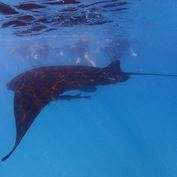Tighter controls urged for manta ray tourism

A new study by Murdoch University has called for tighter control of the manta ray tourism industry at Ningaloo reef.
Honours student Stephanie Venables and researchers from the Murdoch University Coral Bay Research Station developed a case study of manta ray tourism management in the region.
Five dedicated manta ray tour vessels now operate daily out of Coral Bay, which can collectively transport up to 139 passengers to interact with the animals each day.
"Manta ray tourism operates in 25 countries worldwide, bringing in an estimated revenue of over US$73 million per year but the industry is still relatively unregulated," said Ms Venables.
"At Ningaloo, commercial operators are not required to possess a specific manta ray interaction license to conduct tours and the current code of conduct is voluntary."
This code recommends minimum distances for both vessels and swimmers; limits on the number of swimmers permitted in the water; and guidelines for swimmer behaviour and vessel operation.
"This code of conduct was developed around ten years ago after operators expressed concerns regarding the nature of manta ray interactions; specifically the potential for disturbance at reef cleaning stations and animals engaged in courtship activities," Ms Venables added.
"Incidences of seemingly aggressive behaviour of manta rays towards swimmers, such as fin slapping or ramming, were also a cause for concern at the time."
In response to these concerns and observed behavioural changes during interactions, Murdoch University conducted a preliminary assessment of the impact of tourism on manta ray behaviour.
Nearly 100 interactions were observed by researchers over a four month period. Manta rays exhibited responses such as changes in swimming speed and direction, ceasing feeding or leaving the area of a cleaning station during 34 per cent of the observed interactions. The researchers identified a number of factors that influenced how manta rays responded during interactions. These included the behavioural state and maturity of the manta ray, the amount of splashing and the way the swimmers approached the animals.
Ms Venables said: "Although none of these responses seem particularly catastrophic to the animals, these seemingly insignificant disturbances can build up over time and have long-term impacts."
As a response to these concerns, the researchers have recommended that precautions are taken to proactively protect the animals.
"In the same marine park we have a comprehensive and well-managed program in place for interactions with whale sharks, with a well-established licensing system and a mandatory code of conduct," she added
The guidelines are designed to minimise harm to animals and ensure tourist safety, and tourist operators are required to record information daily about the encounters.
These same guidelines have recently been introduced for in-water humpback whale interactions, which are currently being trialed in Ningaloo, setting further precedents for in-water megafauna interactions in the marine park.
"It makes sense for similar management to be developed for manta rays in Ningaloo, which can provide a model for other manta ray tourism locations worldwide," said Ms Venables.
The study was published in Pacific Conservation Biology.
More information: Stephanie Venables et al. Manta ray tourism management, precautionary strategies for a growing industry: a case study from the Ningaloo Marine Park, Western Australia, Pacific Conservation Biology (2016). DOI: 10.1071/PC16003
Provided by Murdoch University

















